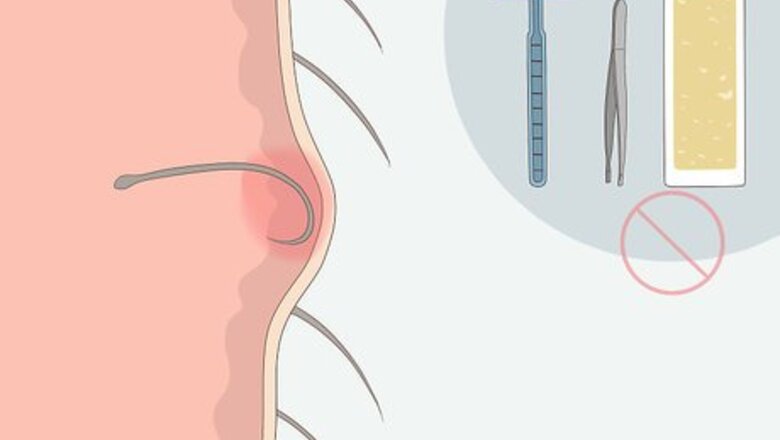
views
Caring for the Ingrown Hair

Stop removing your pubic hair until your ingrown hair heals. You need to leave the area alone so it doesn’t get irritated or develop an infection. After you notice the ingrown hair, stop shaving, waxing, and plucking your pubic area. Let it grow until the ingrown hair goes away. While it might be annoying to let your hair grow, this will help you clear up your ingrown pubic hair much faster. Most ingrown hairs go away on their own in about a month. However, you may be able to remove it faster if you help bring it to the surface.
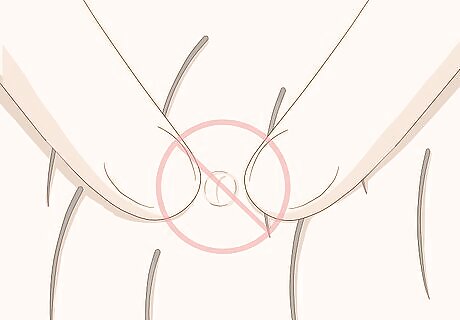
Avoid picking at the ingrown hair because it can cause an infection. While most ingrown hairs don’t get infected, breaking the skin increases your risk of infection. Leave the area alone so that you don’t accidentally damage your skin. You might be tempted to try to dig out or push out the hair. However, this will make it worse.
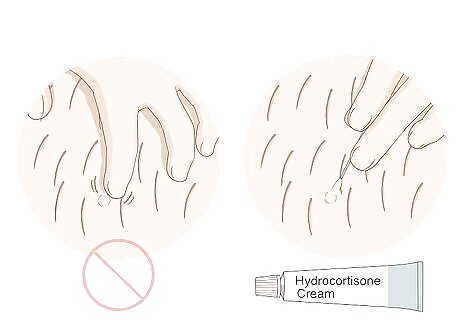
Apply a dab of hydrocortisone cream to relieve itching if there’s no chance you have an infection. It’s common for ingrown hairs to itch, but you shouldn’t scratch it because that could break the skin. Instead, cover the hair with a thin layer of over-the-counter hydrocortisone cream to relieve the itch. Use your cream up to 4 times a day. It’s not safe to use hydrocortisone if you have an infection. If you see any pus, redness, swelling, or other signs of infection you should go a doctor. Read and follow the directions on the label so that you don’t use too much hydrocortisone cream.Variation: Instead of hydrocortisone cream, you can try witch hazel, aloe vera, or benzoyl peroxide. They can help control your itch but may not be as effective as hydrocortisone cream.
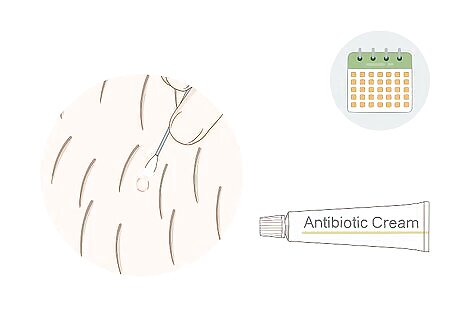
Dab antibiotic cream onto the ingrown hair daily to prevent infection. Your ingrown hair will take a lot longer to heal if it gets infected. To prevent this, apply an over-the-counter antibiotic cream to the area once or twice a day to keep the area clean. You can find an antibiotic cream at your local drugstore or online.
Bringing the Hair to the Surface
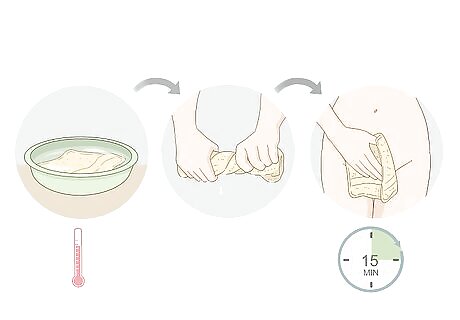
Apply a warm compress for 15 minutes to draw out the hair. Soak a washcloth in hot water, then wring it out so that it’s just damp. Next, press the warm washcloth over your ingrown hair for up to 15 minutes. Repeat this up to 4 times a day, as needed. This will help the hair rise to the surface. You can also use a hot water bottle as a warm compress.
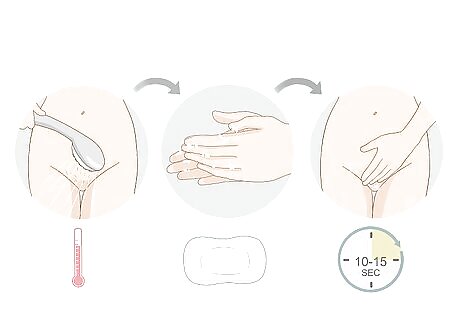
Massage soap and warm water over the ingrown hair for 10-15 seconds. Wet the area around the ingrown hair with warm water. Then, apply soap to your fingers and gently massage the hair for 10-15 seconds. Finally, rinse the area with warm water to wash away the soap. The gentle massage and heat from the water may draw the hair out.
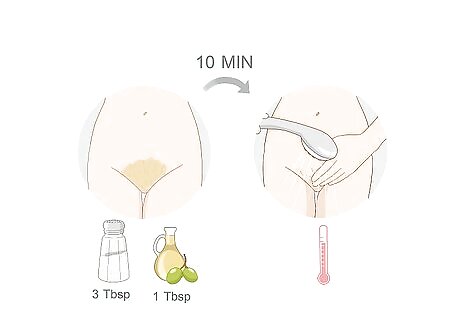
Apply a natural exfoliator for 10 minutes to remove dead skin cells. An exfoliator can remove the dead skin cells that cover the ingrown hair, which might help it surface. Rub your exfoliator over the area, then let it sit for 10 minutes. Next, wet the exfoliator with warm water and gently rub it into your skin as you rinse it off. Here are some natural exfoliators you can use: Make a paste with 1/2 cup (110 grams) of brown or white sugar and about 3 tablespoons (44 mL) of olive oil. Mix 3 tablespoons (15 grams) of used coffee grounds with 1 tablespoon (15 mL) of olive oil. Mix 3 tablespoons (38 grams) of salt with 1 tablespoon (15 mL) of olive oil. Mix 1 teaspoon (6 grams) of baking soda with just enough water to make a paste.Variation: Use a commercial body scrub or body exfoliator if you don't want to make your own.
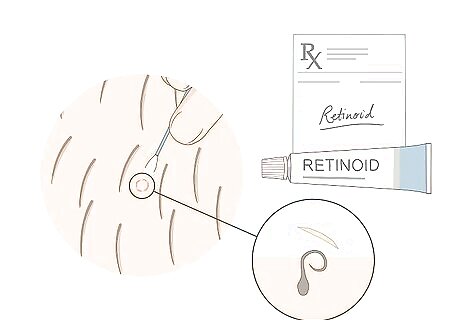
Ask your doctor about retinoids to remove the top layer of skin. For stubborn ingrown hairs, you might use prescription retinoids to remove the top layer of your skin cells. This usually causes the hair to surface. Talk to your doctor to find out if this is an option for you. Then, use your topical treatment as directed. You can only get retinoids by prescription.
Removing the Hair
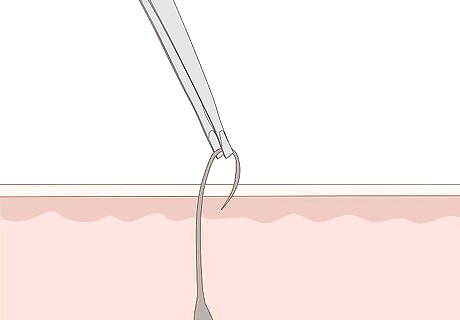
Place your sterilized tweezers over the rounded part of the hair. Your hair should look like a loop or like it’s growing to the side. Since it’s hard to see which end is the top of the hair, always pull on the middle area of the hair until the end surfaces.Variation: Use a sterile needle to pull out the end of the hair instead of your tweezers. Insert the end of the needle under the loop of the hair and gently lift. The end of the hair should come out. However, don’t dig into your skin.
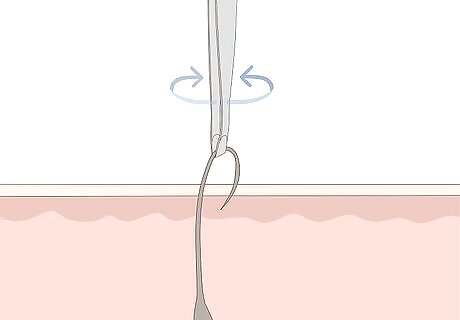
Rotate your tweezers back and forth until the end of the hair comes out. Grasp the hair with your tweezers, then gently tug the hair to the right. Next, twist the hair to the left. Keep rotating the tweezers until the end comes out. If you pull the hair directly up, it will hurt a lot when the hair comes out. It’s better to work the end of the hair out and then pluck the hair. Make sure you’re not digging the ends of your tweezers into your skin.
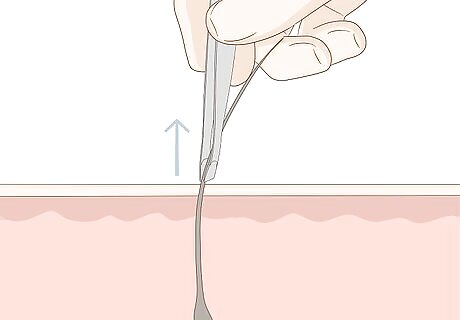
Pluck out the hair once the end emerges from under your skin. After you’ve dislodged the end of your hair, you can remove it with your tweezers. Place the tweezers near the base of the hair, then quickly pull out the hair. At this point, your ingrown hair will be gone. Pulling out the hair will likely cause a little discomfort. However, it shouldn’t be very painful.

Wash the area with soap and warm water to clean it. Wet the area with warm water, then massage soap into it. Next, wash away the soap with warm, running water. This will make sure dirt and bacteria don’t get into the empty hair follicle. Pat your skin dry with a clean towel or let it air dry.
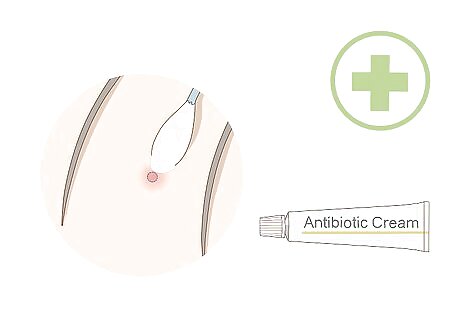
Apply an antibiotic cream to the area to help it heal. Use your finger or a cotton swab to dab antibiotic cream over the empty hair follicle. This will prevent an infection and speed up the healing process. Additionally, using the antibiotic cream may also help prevent scarring.
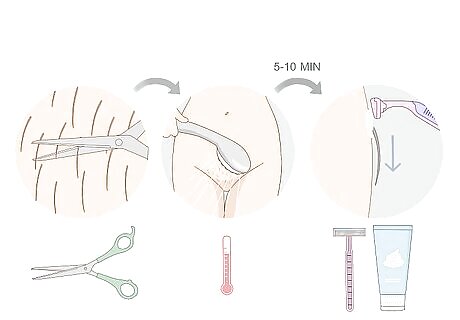
Change your shaving routine to reduce the risk of another ingrown hair. Trim your hair short with scissors before shaving. Then, soak in a hot shower, bath, or with a warm compress for 5-10 minutes before shaving. Use a gentle unscented shaving cream and shave in the same direction as your hair grows. Moisturize and wear cotton underwear afterwards to reduce chafing. Consider using electric clippers, which can get hairs shorter instead of totally shaving them off. Consider laser hair removal from a dermatologist to permanently remove hair if you frequently get ingrown hairs.
Dealing with an Infected Ingrown Hair

See your doctor if you notice signs of an infection. It’s possible for your ingrown hair to get infected, especially if you break the skin. If you have an infection, you need to get proper treatment so it heals. Talk to your doctor if you notice the following symptoms of an infection: Pus Pain Redness Swelling

Use an antibiotic as directed if your doctor prescribes it. If you have an infection, your doctor may prescribe you an antibiotic. For a mild infection, you’ll likely use a topical antibiotic. For a severe infection, your doctor might give you an oral antibiotic. Take your medication as directed so that your infection heals. Don’t stop taking your antibiotic until you’ve used your entire prescription. Otherwise, your infection may come back. You don’t need an antibiotic unless you actually have an infection. It won’t help your ingrown pubic hair go away.
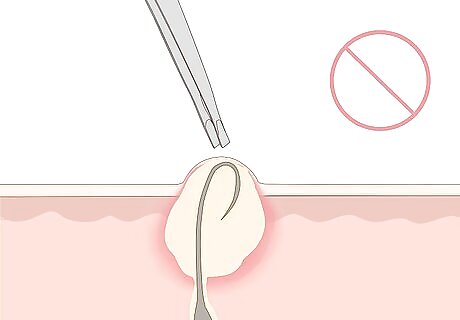
Don’t try to remove the hair until the area heals. While you’re treating the infection, you need to leave the hair alone. Trying to pull it out can make the infection worse. Ask your doctor when it’s okay to try to remove your ingrown pubic hair. It’s possible that your pubic hair will emerge on its own as your infection clears.


















Comments
0 comment